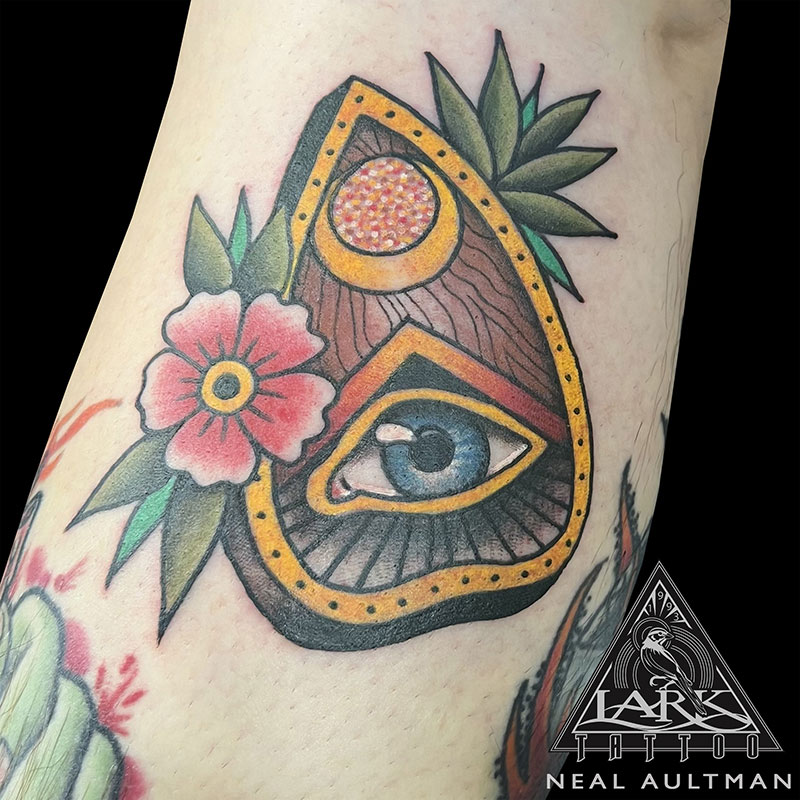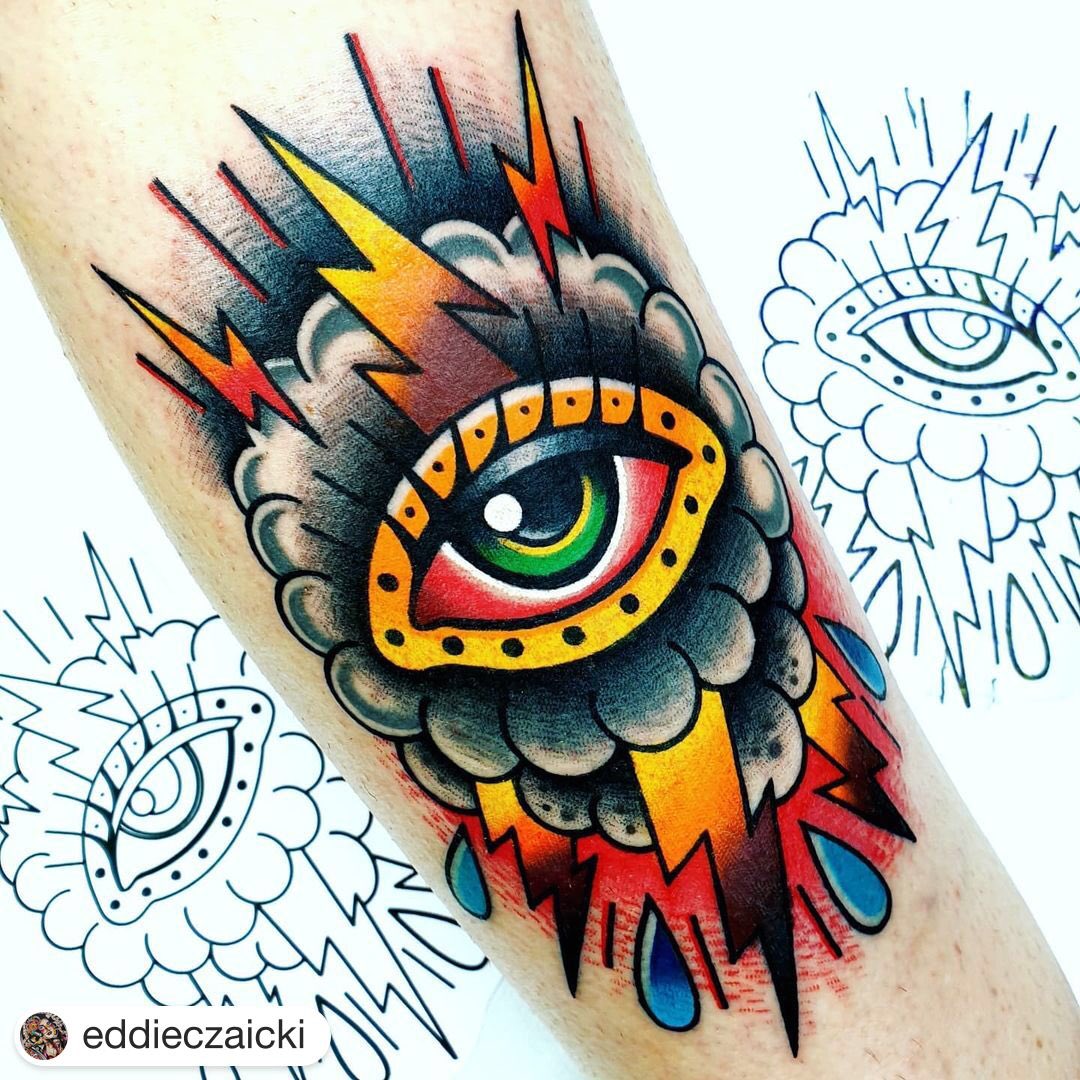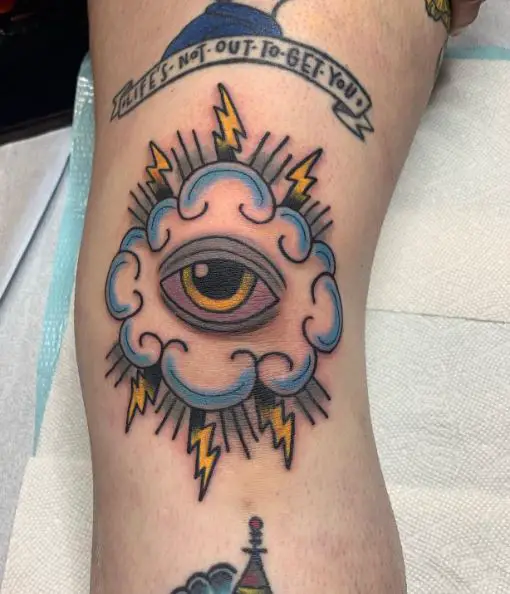Traditional eye tattoo is a popular design choice among tattoo enthusiasts across the globe. Eye tattoos are versatile, and they can be customized in many ways to convey various meanings. In this article with Impeccable Nest, we will delve deep into the traditional eye tattoo meaning and design, exploring the symbolism behind this timeless design.

A Brief History of Traditional Eye Tattooing Practices
The practice of tattooing around the eyes has existed for thousands of years in many parts of the world. Some of the earliest evidence comes from mummified remains in ancient Egypt dating back over 4,000 years ago.
However, most well-known traditional eye tattooing comes from Polynesian and North African cultures. These practices were deeply woven into cultural identity and rituals.
Maori Moko
In New Zealand, the indigenous Maori people practiced sacred facial tattoos called moko. Moko holds deep social and spiritual significance. They represented family lineage, social status, rites of passage, and more.
Intricate designs were tattooed around the eyes, nose, chin, and forehead. Only those of high rank would receive moko on the face. The eye tattoos in particular symbolized enhanced eyesight and a window to the soul.

North African Eye Tattoos
In parts of North Africa, Berber and Tuareg groups have long practiced facial and eye tattoos. For Tuareg men, eye tattoos held medical benefits and represented maturity and social status.
The tattoos were created using rudimentary needles and black pigments like soot. These permanent tattoos had antiseptic properties that protected against eye infections and vision loss from desert sands and bright sunlight.

Understanding the Traditional Eye Tattoo Meaning
The traditional eye tattoo symbolizes different things to different people. Some associate it with wisdom, enlightenment, and intuition. Others see it as a symbol of protection, vigilance, and clarity. Here are some common meanings associated with the traditional eye tattoo:

Identity and Belonging
Eye tattoos, also known as scleral tattoos or corneal tattoos, involve injecting ink into the whites of the eyes to change their color or create designs. While this type of tattoo has gained popularity in recent years, it is important to note that it can be a risky and potentially harmful procedure.
However, when we talk about facial tattoos like moko, which are traditional tattoos of the Maori people of New Zealand, they hold great cultural significance and meaning. These types of tattoos are not done for cosmetic purposes or personal expression but serve as a visual representation of one’s ancestry, family history, and societal standing.
The moko design typically covers the entire face and is unique to each individual, based on their genealogy and life experiences. It is a sacred art form that represents one’s whakapapa, or genealogy, and links them to their ancestors and the wider community.

In Maori culture, the moko is an integral part of one’s social identity and belonging to a cultural group. It shows that one has earned their place within the community and has lived up to the responsibilities and expectations of their ancestors. It is a symbol of pride, strength, and connection to one’s heritage.
The placement and design of the moko can also indicate one’s rank, status, and achievements within the community. For example, men may have more elaborate designs than women, and leaders may have distinctive markings on their forehead or chin.
The process of receiving a moko is a significant event and involves both physical and spiritual preparation. The tattoo artist, or tohunga tā moko, must first establish a connection with the person and their whanau, or family, to understand their background and aspirations. They then use traditional tools, such as chisels and ink, to create the intricate designs.
Overall, while eye tattoos may have different connotations in modern tattoo culture, traditional facial tattoos like moko hold a profound significance in the culture and history of certain communities. They represent a deep connection to one’s heritage, social identity, and sense of belonging within a wider community, solidifying one’s place in the world.
Spiritual Protection
Eye tattoos have been around for centuries, and they hold significant meaning in certain cultures and traditions. In some cultures, the eye area is seen as a vulnerable entry point for spirits. For this reason, people often get eye tattoos as a means of spiritual protection and guardianship.
In many cultures, ancestor worship plays an important role in daily life. Ancestors are believed to have the power to protect and guide their living descendants. Eye tattoos are one way that people show reverence to their ancestors and ask for their protection.
In some cultures, the eye tattoo takes on the form of an actual eye. This may be a single eye or multiple eyes, depending on the specific tradition. The eye represents the all-knowing, all-seeing wisdom of the ancestors. It also serves as a warning to malevolent spirits that may try to harm the person with the tattoo.
Other cultures have different interpretations of the eye tattoo. For example, in ancient Egypt, the eye was a symbol of Horus, the god of the sky and protector of the pharaohs. The eye was believed to represent both physical sight and spiritual insight, making it an important symbol for those seeking protection and guidance.

In modern times, eye tattoos have become more popular in mainstream culture. While some people get them for purely aesthetic reasons, others still see them as a symbol of protection and spirituality. People may choose to get an eye tattoo to honor their ancestors, connect with their spiritual side, or simply as a reminder of the power of the all-seeing eye.
It’s important to note that getting an eye tattoo is not a decision to be taken lightly. As with any tattoo, there are potential risks involved, including infection and allergic reactions to the ink. Additionally, some cultures may view eye tattoos as disrespectful or inappropriate if the person getting the tattoo does not have a cultural connection to the symbolism behind it.
In conclusion, the meaning behind an eye tattoo can vary depending on culture and tradition. For many, it represents spiritual protection and guardianship, especially in traditions involving ancestor worship. Whether you choose to get an eye tattoo for its aesthetic appeal or its deeper symbolic meaning, it’s important to approach the decision with care and respect for the cultural significance behind it.
Insight and Vision
Tattoos have been around for centuries, and they continue to be a popular form of self-expression even today. One particular type of tattoo that has gained popularity over the years is the eye tattoo.
The eye tattoo is a unique design that typically consists of an image of an eye or eyes, usually located around the eye area. While some people may choose this tattoo simply because they like the way it looks, others may choose it for its deeper symbolic meaning.
In general, tattoos around the eyes are believed to represent enhanced sight. This can refer to physical vision, as in the ability to see more clearly, or to metaphysical insight, such as increased spiritual awareness. By getting an eye tattoo, one is essentially acknowledging their desire to see more clearly into both the material and spiritual worlds.

From a physical perspective, the eye tattoo can represent a desire for clearer vision. This could mean wanting to see better without glasses or contacts, or simply wanting to be more observant of the world around you. In this context, the eye tattoo can serve as a reminder to stay vigilant and aware of your surroundings.
On a deeper level, the eye tattoo can also represent increased spiritual awareness or intuition. The eye is often associated with wisdom, knowledge, and insight, and by getting an eye tattoo, one is essentially saying that they want to tap into these qualities in order to gain a greater understanding of themselves and the world around them.
In some cultures, the eye tattoo has specific meanings. For example, in Egyptian mythology, the Eye of Ra symbolized protection, healing, and restoration. Meanwhile, in Hinduism, the third eye is believed to represent spiritual enlightenment and the ability to see beyond the physical realm.
Ultimately, the meaning behind an eye tattoo will depend on the individual and what they hope to achieve through the tattoo. Some may see it as a symbol of protection, while others may view it as a reminder to stay focused and observant. Whatever the meaning, the eye tattoo remains a popular choice for those seeking both aesthetic appeal and deeper significance in their tattoos.
Status and Maturity
Eye tattoos have become increasingly popular in recent years, and they hold a significant meaning for those who choose to adorn their faces with this particular symbol. While some people may simply view eye tattoos as a decorative or aesthetic choice, these tattoos have a long history of cultural significance and symbolism.
In many cultures, facial tattoos are seen as a mark of adulthood and a sign of social status. In some societies, these tattoos are reserved for individuals who have reached certain milestones, such as marriage, childbirth, or completion of a rite of passage. In other cultures, facial tattoos denote specific roles or responsibilities within the community, such as leadership positions or spiritual leaders.
When it comes to eye tattoos specifically, there are several potential meanings that can be attributed to this symbol. For some individuals, an eye tattoo may represent awareness or perception. It can serve as a reminder to remain present and mindful throughout daily life, or it may signify a desire to see things clearly and without distortion.

Others may choose to get an eye tattoo as a symbol of protection or guidance. The eye has long been associated with the concept of “the evil eye,” a belief held by various cultures that certain individuals possess the power to cause harm through their gaze. By getting an eye tattoo, some people feel that they are protecting themselves from negative energies or warding off harmful intentions from others.
Additionally, eye tattoos may hold spiritual or mystical significance for some individuals. The third eye, located in the center of the forehead, is often associated with intuition, higher consciousness, and spiritual awakening. Some people choose to get an eye tattoo in this location as a way to connect with their spiritual selves or to remind themselves of the importance of inner vision and intuition.
Of course, the meaning of an eye tattoo can vary widely depending on the individual who chooses to get one. For some, it may simply be a way to express their creativity or personal style. For others, it may hold deeply personal meaning that is difficult to articulate.
Regardless of the specific symbolism attached to an eye tattoo, it’s clear that facial tattoos in general have long held significant cultural significance. From denoting social status to marking major life events, these tattoos are more than just a decorative choice – they serve as a visual representation of one’s place within their community and their personal journey through life.
Bridging Worlds
Eye tattoos have gained immense popularity in recent years due to their unique and captivating designs. But beyond just the aesthetic appeal, these tattoos hold significant meaning and symbolism that can vary depending on cultural and personal interpretations.
One of the most common meanings associated with eye tattoos is the concept of linking the outer and inner worlds. The eyes are often regarded as a window to the soul, a portal that connects the physical body with the spiritual realm. In this sense, an eye tattoo can serve as a reminder to stay grounded in the present moment while also acknowledging the deeper spiritual aspects of our existence.
Furthermore, eye tattoos can also symbolize a connection with one’s ancestors and the past. Across many cultures, there is a belief that our ancestors continue to watch over us even after they have passed away. Through an eye tattoo, we can honor and pay tribute to these individuals who have shaped our lives and helped us become who we are today.

In some cultures, the eye also represents protection and warding off evil spirits or negative energies. In ancient Egyptian mythology, the Eye of Ra was a symbol of protection, representing the sun god’s power to keep darkness at bay. Similarly, in traditional Middle Eastern cultures, the “evil eye” is thought to be a curse caused by jealousy or envy and can be warded off through various protective measures such as wearing amulets or getting a tattoo of an eye.
Another interpretation of eye tattoos is related to the concept of perception and vision. The eyes are our primary sensory organs, allowing us to see and interpret the world around us. An eye tattoo can serve as a reminder to stay open-minded, to not judge things based solely on appearance, and to seek truth and wisdom beyond what is immediately visible.
In conclusion, the meaning of an eye tattoo can vary widely depending on personal beliefs and cultural influences. Whether it serves as a connection to the past, a symbol of protection, or a reminder of the importance of perception and awareness, an eye tattoo can hold deep significance for the individual who wears it.
Traditional Eye Tattooing in Today’s World
Attitudes toward traditional tattoos have shifted over time as these practices fade. Once an integral rite of passage, facial tattoos became stigmatized as many indigenous groups faced colonization.
Today, revived interest in tradition has brought more acceptance and appreciation for permanent body modifications like eye tattoos. However, important social nuances remain regarding who participates in these practices.
In New Zealand, moko is being revitalized as a sacred cultural symbol. But popular use of Maori-inspired tribal tattoos by non-indigenous people remains controversial. Issues of cultural appropriation versus appreciation are debated.
For many indigenous peoples, eye tattoos still hold deep traditional meaning and heritage. Their significance is complex, personal, and rooted in centuries of culture and belief.

Examples of Traditional Eye Tattoo Meaning
Here are some examples of traditional eye tattoo designs and their meanings:
- Third Eye: The third eye is a popular traditional eye tattoo design that represents intuition, insight, and spiritual awareness.
- Egyptian Eye: The Egyptian Eye (also known as the Eye of Horus) is a common traditional eye tattoo design that symbolizes protection, healing, and power.
- Evil Eye: The Evil Eye is another popular traditional eye tattoo design that is believed to ward off evil spirits and negative energy.
Comparisons of Traditional Eye Tattoo Meaning
The traditional eye tattoo is a timeless design that has transcended cultures and eras. It is often compared to other eye tattoos, such as the realistic eye tattoo and the watercolor eye tattoo. Here are some differences between these types of eye tattoos:
- Realistic Eye Tattoo: The realistic eye tattoo is a highly detailed design that mimics the look of a real eye. It’s often used to convey emotion, depth, and realism.
- Watercolor Eye Tattoo: The watercolor eye tattoo is an abstract design that uses vibrant colors and brushstrokes to create a dreamy, ethereal effect. It’s often used to represent imagination, creativity, and fantasy.
Conclusion
In conclusion, the traditional eye tattoo is a timeless design that carries deep meaning and symbolism. Whether you’re looking for wisdom, protection, or clarity, a traditional eye tattoo can be customized to reflect your intentions and personality. By understanding the meaning and significance of this design, you can make an informed decision and choose a design that resonates with you. Remember to take your time, research different designs, and communicate with your tattoo artist to create a meaningful and beautiful traditional eye tattoo.

I am Harvey Berry, a tattoo enthusiast who has immersed himself in the diverse world of ink, passionately exploring the beauty and artistry within each tattoo. My mission extends beyond uncovering the aesthetics of tattooing; it involves sharing in-depth knowledge across all aspects of this art form.
Fueled by genuine curiosity and love for every facet of tattooing, I have diligently crafted well-researched articles, with a special focus on the Tattoo Meaning of Impeccable Nest section. Here, my aim is to help the tattoo community gain a deeper understanding of the meanings and values embedded in each tattoo.
One of my primary goals is to encourage responsible decision-making when it comes to getting inked. I recognize that choosing to get a tattoo is a significant personal decision that requires careful consideration. Hence, I provide diverse resources covering the meaning of tattoos, the tattooing process, aftercare tips, and other valuable information.
Whether you are a seasoned tattoo enthusiast or embarking on your first exploration of the world of body art, I aspire to be a reliable resource for you at every step of your journey. I hope that my extensive knowledge of tattoos, especially in the Tattoo Meaning section, will assist you in finding inspiration to express yourself through the art of tattoos.
